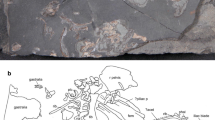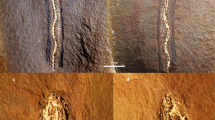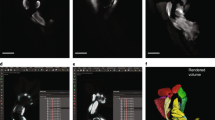Abstract
NEW specimens of the earliest known tetrapod limbs shows them to be polydactylous. The forelimb of Acanthostega has eight digits and the hindlimb of Ichthyostega has seven. Both of these come from the Upper Devonian of East Greenland, complementing the only other known Devonian tetrapod limb, that of Tulerpeton from Russia1, which has six digits. The morphology of the specimens suggests that limbs with digits may have been adaptations to an aquatic rather than a terrestrial environment. The pattern of digits corresponds to a recently proposed model for limb development2 in which digit number is unspecified, rather than earlier models3–10 which are rejected because they postulate a fixed number of elements in the ancestral limb. We challenge pentadactyly as primitive for tetrapods3,11. The form of these limbs suggests early specialization in the evolution of the tetrapod limb bud.
This is a preview of subscription content, access via your institution
Access options
Subscribe to this journal
Receive 51 print issues and online access
$199.00 per year
only $3.90 per issue
Buy this article
- Purchase on Springer Link
- Instant access to full article PDF
Prices may be subject to local taxes which are calculated during checkout
Similar content being viewed by others
References
Lebedev, O. A. Dokl. Akad. Nauk SSSR 278, 1407–1473 (1984).
Shubin, N. H. & Alberch, P. Evol. Biol. 20, 319–387 (1986).
Jarvik, E. Basic Structure and Evolution of Vertebrates Vol. 2 (Academic, London, 1980).
Gegenbaur, C. Morph. Jb. 2, 396–420 (1876).
Watson, D. M. S. Anat. Anz. 44, 24–27 (1913).
Gregory, W. K., Miner, R. W. & Noble, G. K. Bull. Am. Mus. nat. Hist. 48, 279–288 (1923).
Gregory, W. K. & Raven, H. C. Ann. N. Y. Acad. Sci. 42, 273–360 (1941).
Holmgren, N. Acta zool. 14, 185–295 (1933).
Westoll, T. S. Proc. R. Soc. B131, 373–393 (1943).
Steiner, H. Rev. Suisse. Zool. 41, 383–396 (1934).
Goodrich, E. S. Studies on the Structure and Development of Vertebrates (Macmillan, London, 1930).
Panchen, A. L. Nature 333, 704 (1988).
Jarvik, E. Basic Structure and Evolution of Vertebrates Vol. 1 (Academic, London, 1980).
Smithson, T. R. Zool. J. Linn. Soc. 85, 317–410 (1985).
Holmes, R. Phil. Trans. R. Soc. B306, 413–527 (1984).
Andrews, S. M. & Westoll, T. S. Trans. R. Soc. Edinb. 68, 207–329 (1970).
Panchen, A. L. & Smithson, T. R. Biol. Rev. 62, 341–438 (1987).
Rackoff, J. S. in The Terrestrial Environment and the Origin of Land Vertebrates (ed. Panchen, A. L.) 255–292 (Academic, London, 1980).
Wood, S. P., Panchen, A. L. & Smithson, T. R. Nature 314, 355–356 (1985).
Smithson, T. R. Nature 342, 676–678 (1989).
Godfrey, S. J. Phil. Trans. R. Soc. B323, 75–133 (1989).
Panchen, A. L. & Smithson, T. R. in The Phytogeny and Classification of the Tetrapods. Volume 1: Amphibians, Reptiles, Birds (ed. Benton, M. J.) 1–32 (Clarendon, Oxford, 1988).
Bjerring, H. C. in Evolutionary Biology of Primitive Fishes (eds Foreman, R. E. et al.) (Plenum, New York, 1985).
Edwards, J. L. Am. Zool. 29, 235–254 (1989).
Muller, G. B. & Alberch, P. J. Morph. 203, 151–164 (1990).
Hinchliffe, J. R. & Griffiths, P. J. in Development and Evolution (eds Goodwin, B. C. et al.) 99–121 (Cambridge University Press, Cambridge, 1983).
Hinchliffe, J. R. in Fortschritte der Zoologie Vol. 35 (eds Splechtna, H. & Hilgers, C. H.) 226–229 (Gustav Fischer Verlag, Stuttgart, 1989).
Oster, G. F. et al. Evolution 42, 862–884 (1988).
Goodwin, B. C. & Trainor, L. E. H. in Development and Evolution (eds Goodwin, B. C. et al.) 75–98 (Cambridge University Press, Cambridge, 1983).
Hinchliffe, J. R. in Complex Organismal Functions: Integration and Evolution in Vertebrates (eds Wake, D. B. & Roth, G.) 171–189 (Wiley, Chichester, 1989).
Danforth, C. H. Am. J. Anat. 80, 143–171 (1947).
Rosen, D. E. et al. Bull. Am. Mus. nat. Hist. 67, 159–276 (1981).
Brickell, P. M. & Tickle, C. BioEssays 11, 145–149 (1989).
Wolpert, L. in Development and Evolution (eds Goodwin, B. C. et al.) 47–51 (Cambridge University Press, Cambridge, 1983).
Saunders, J. W. in Vertebrate Limb and Somite Morphogenesis (eds Ede, D. A. et al.) 1–24 (Cambridge University Press, Cambridge, 1977).
Hinchliffe, J. R. & Johnson, D. R. The Development of the Vertebrate Limb (Clarendon, Oxford, 1980).
Holder, N. J. theor. Biol. 104, 451–471 (1983).
Author information
Authors and Affiliations
Rights and permissions
About this article
Cite this article
Coates, M., Clack, J. Polydactyly in the earliest known tetrapod limbs. Nature 347, 66–69 (1990). https://doi.org/10.1038/347066a0
Issue Date:
DOI: https://doi.org/10.1038/347066a0
This article is cited by
-
Affinity-optimizing enhancer variants disrupt development
Nature (2024)
-
Lepidoptera demonstrate the relevance of Murray’s Law to circulatory systems with tidal flow
BMC Biology (2021)
-
Combined oxygen and sulphur isotope analysis—a new tool to unravel vertebrate (paleo)-ecology
The Science of Nature (2020)
-
Morphology of the earliest reconstructable tetrapod Parmastega aelidae
Nature (2019)
-
Evidence against tetrapod-wide digit identities and for a limited frame shift in bird wings
Nature Communications (2019)
Comments
By submitting a comment you agree to abide by our Terms and Community Guidelines. If you find something abusive or that does not comply with our terms or guidelines please flag it as inappropriate.



